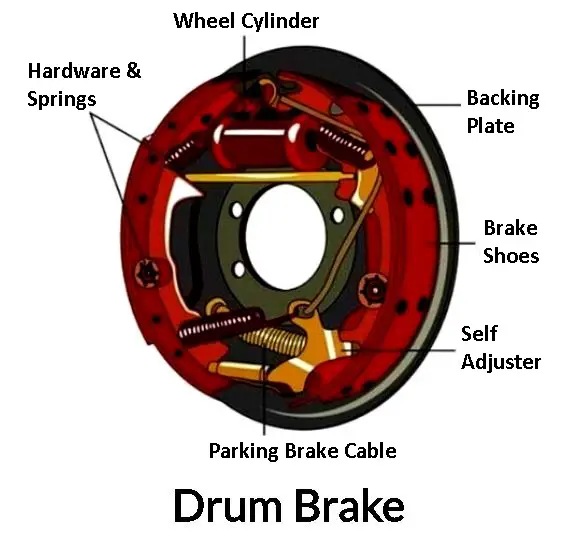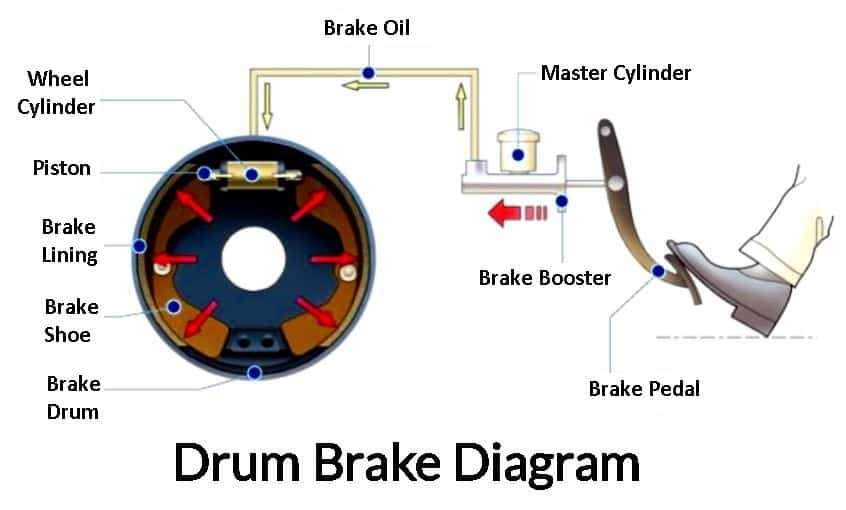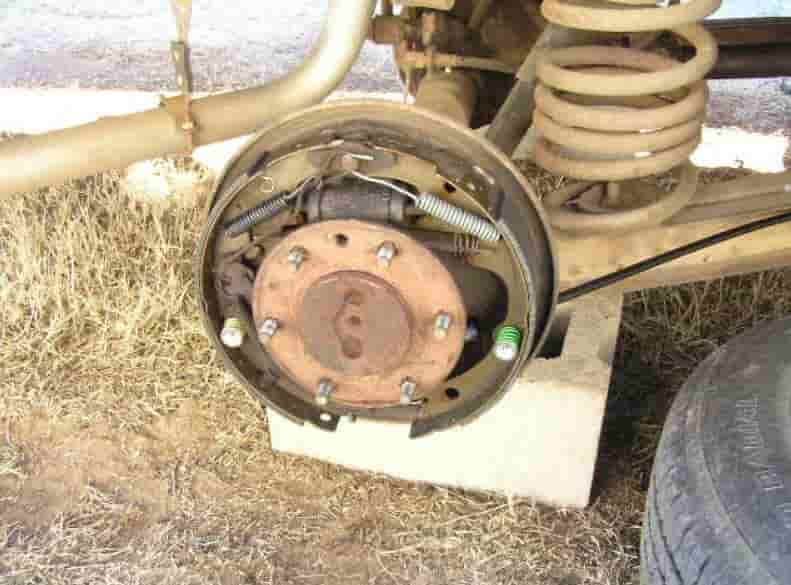Hello readers! In this post, we’ll discuss what is Drum Brake? Its diagram, parts, working, advantages, and applications using illustrations.
So let’s start with what is a Drum Brake.
What is Drum Brake?
A brake drum is a rotating, cylinder-shaped part that exerts pressure outwardly on a set of shoes or pads to produce friction. Drum brakes are brakes where the shoes press against the inner surface of the drum.
When shoes contact the outside of the drum, it is commonly referred to as a clasp brake. Despite being extremely rare, these brakes are frequently referred to as pinch drum brakes because the drum is squeezed between two shoes, much like a conventional disc brake.
Drum brakes can be categorized as leading/trailing or twin leading. Typically, rear drum brakes are designed with leading/trailing or primary/secondary shoes that are moved by a single double-acting hydraulic cylinder and hinged in the same place. When the vehicle travels forward or backward, one brake shoe always experiences the self-applying effect.
This is especially useful when applying the rear brakes, as the parking brake (handbrake) must exert enough force to keep the vehicle in place and prevent rolling backward. In the event of inclining or reversing motion, the self-applying effect can safely maintain a vehicle provided that the contact area of the brake shoes is large enough.
Let’s discuss the important parts of the drum brake.
Read Also: Difference Between Drum Brake & Disc Brake
Parts of Drum Brake
The following are the most important parts of a drum brake:
- Drum brake
- Braking plate
- Brake shoe with pads
- Wheel cylinders
- Brake lever
- Brake shoe holder
- Return spring
- Parking brake cable
- Brake shoe adjuster

#1 Drum Brake
In the drum brake work system, this part plays an important role. Because this component is made of cast steel, it has a tough texture and the shape of a drum or tube.
The primary function of this part is to provide a medium for friction with the brake pads in order for the wheels to stop on the road. This component is also directly connected to the wheel bolts, allowing the drum to rotate in tandem with the wheel bolts.
#2 Braking Plate
The backing plate is one of the drum brake system’s parts. It takes the shape of a thin metal band that is attached to the system’s back. This component protects the other components of the drum brake.
The backing plate is shaped like a circle with numerous holes and protrusions. The backing plate’s primary function in having a certain number of holes is to match the standard component of the drum brake.
#3 Brake Shoe with Pads
Another part that is frequently found in a drum brake is brake shoes and brake pads. A drum brake system’s brakes are applied using a brake shoe or brake pad. The brake pad is where the brake pads should be placed in the disc brake parts.
Typical brake shoes have a shape that resembles a circle made up of two shoes connected by a semicircle. Despite the fact that the brake shoe is installed in one area of the drum brake, it will not come into direct contact with the drum.
Components like brake pads are applied directly to the brake shoe’s surface. When the brake pads are worn or in poor condition, they can be changed or replaced because the material used to make them is an organic ceramic.
#4 Wheel Cylinders
Drum brake components, such as wheel cylinders, are useful for transforming fluid pressure into mechanical motion. Drum brake systems typically use or contain a variety of wheel cylinder types.
Due to its frequent use in conjunction with leading and trailing drum types, the dual piston wheel cylinder type is the most common. Bolts are the best way to distinguish the double piston type from the backing plate.
The wheel cylinder is made up of several components, including the wheel cylinder housing, bleeder nut, piston boot, spring, and piston. If one of the wheel cylinders is malfunctioning, the drum brakes’ effectiveness will be reduced.
You might like: Different Types of Transmission Systems Used In Vehicle
#5 Brake lever
Drum brake components such as the parking brake lever can only be found on cars since motorbikes won’t use them. The drum brake assembly will appear more complex with the parking brake lever. The park brake lever and the brake shoe link are the two levers of the parking brake lever system.
The parking brake lever consists of an arm that has a hinge at one end that is attached to the brake shoe on the upper side and the brake cable at the other end. While the brake shoe link will connect the park brake lever to the opposite brake shoe.
#6 Brake Shoe Holder
The brake shoes will naturally be mounted or stored attached to the backing plate in a car drum braking system. The brake shoe holder moves easily or is dynamic. In this manner, the holder mechanism can properly support the drum brakes.
The brake shoe holder is comprised of a number of pins with spring locks or spring-loaded pins as well as a pressure plate. When the three parts are joined together, they form a critical component that connects to the backing plate.
#7 Return Spring
Return springs are brake components that are no less important because they return the brake shoe to its original position before the brake lever or pedal pressure is applied. The upper and lower springs are the two return springs in this braking system.
Upper springs are springs that are located above or beneath the cylinder wheel. The upper spring’s main job is to put the brake shoe back in its original place.
The lower spring, which lies on the adjuster’s side, serves a very different purpose from the upper spring. The lower spring keeps the two brake shoes in place so they can apply pressure to the adjuster.
#8 Parking Brake Cable
The parking brake cable is typically used to pull the brake system. It is made of steel. Similar to other steel cables, the used type of cable is not particularly unique.
The parking brake cable’s main job is to link the brake system’s parking brake lever to the parking brake lever movement.
#9 Brake Shoe Adjuster
One of the drum brake components is the brake shoe adjuster, which is shaped like the adjuster’s screw. These brakes have a shoe adjuster, which is a significant part.
The brake shoe adjuster adjusts the distance between the drum brake pads and the drum surface when the brake pedal is depressed.
Below is the Diagram of Drum Brake:

You might like: How Does A Air Brake System Work?
Working of Drum Brake
When the driver presses the brake pedal, the brake booster (vacuum servo) increases the force, which the master cylinder converts to hydraulic pressure (oil pressure). The pressure is transferred to the brakes on the wheels (brake fluid) by means of a tube filled with brake oil.
The applied pressure pushes the pistons on the four-wheel brakes. By pressing friction materials onto the brake drums, the pistons press the brake linings onto the interior surfaces. The rotating drums have linings forced onto them, which slows the wheels down and eventually brings them to a stop.
As the brake linings wear out, the shoes must travel a greater distance to reach the drum. When the distance between the shoes and the drum reaches a certain point, a self-adjusting mechanism moves the shoe’s resting position closer to the drum.
Here, the adjustment lever can only be adjusted to advance the adjuster gear by one tooth. The adjuster has a threaded design similar to a bolt so that as it turns, a small amount of the threads unscrew and stretch, bridging the gap.
Since the brake shoes can advance once they begin to wear a little more, the adjustment always keeps them close to the drum. The adjusters frequently function with the brakes applied and the vehicle in reverse.
On vehicles without automatic adjusters, it may be necessary to manually adjust the brakes to close excessive gaps. The parking (or emergency) brake system operates the brakes through a network of steel cables that are connected to either a foot pedal or a hand lever.
The mechanical brake system is designed to stop the car even if the hydraulic brakes completely fail. In this instance, a brake-mounted lever is pulled by a cable that is fastened directly to the brake shoes.
Types of Drum Brakes
There are three main types of drum brakes:
- Leading/trailing shoe-type drum brake
- Duo servo type drum brake
- Twin leading shoe type drum brake
#1 Leading or Trailing Shoe-type Brake
The term “leading shoe” (or “primary shoe”) refers to the rotating shoe that touches the drum. The other shoe is known as the “trailing (secondary) shoe”. As the drums rotate, the shoes are pressed in the same direction. This rotation helps apply more pressure to the shoes’ contact with the drum for a stronger braking effect.
This causes the servo effect (self-boosting effect), which is what gives drum brakes their powerful braking power. The wheel cylinder, which contains a piston, creates hydraulic pressure that pushes the two shoes against the drum’s interior surface.
When the vehicle is moving forward or backward, the two shoes function so that each one becomes either the trailing shoe or the leading shoe. The brakes generate consistent braking force whether the vehicle is moving forward or backward.
This is explained by the fact that drum brakes generate the same amount of braking force in both directions. Usually, this type of system is used for the passenger car’s rear brakes.
#2 Duo Servo Type Brake
The mechanism of the duo servo type has an adjuster that connects two brake shoes, known as the primary shoe and secondary shoe.
The primary shoe’s servo effect (self-boosting effect), which exerts strong pressure on the linked secondary shoe, generates a sizable amount of braking force. There are three main uses for this type of brake are parking brakes, truck center brakes, and forklift brakes.
#3 Twin Leading Shoe Type Brake
This drum brake has two wheel cylinders and two leading shoes. Since each wheel cylinder pulls on one of the shoes when the car is moving forward, both shoes work as the leading ones, giving the brakes a stronger stopping force.
Since each of the pistons located in the wheel cylinders moves in only one direction, both shoes act as the trailing ones when the car is in reverse. This type is frequently used for front brakes on small- to mid-sized trucks.
Using dual twin leading shoes allows both shoes to operate as the leading ones regardless of which direction the vehicle is moving. Most of these are found on small to medium-sized trucks with rear brakes.
The common symptoms of a bad drum brake are described below.
You might like: Everything You NeedTo Know About The Camshaft
Symptoms of a Bad Drum Brake
Drum brake issues on your car can be detected in a number of ways. Observe these symptoms if you think your brake drums may be failing:

#1 Scraping or Grinding Noise
Drum brakes comprise several components that work together to slow your car down. When a brake shoe’s friction material wears out, the backing plate will come into contact with the brake drum. Every time you apply the brakes, it makes a grinding noise.
Due to missing or damaged brake parts, such as retaining springs, drum brakes can also make strange noises. Additionally, brake drums that gather dirt, mud, and brake dust may make odd noises. It is therefore best to have the sound evaluated by a qualified mechanic.
#2 Low Brake Pedal
A low brake pedal might be an indication that the brake shoe and drum are too far apart. It might also be the result of a leaking master cylinder or brake fluid.
When applying the brakes, a broken master cylinder will improperly distribute hydraulic pressure, resulting in an immediate pedal depress. Rarely, similar symptoms may also be brought on by internal fluid leaks in anti-lock brake components.
#3 Poor Braking Performance
When you press the brake pedal, if your car doesn’t stop or slow down right away, there may be a problem with the brake shoe or drum. However, in vehicles with front disc brakes and rear drum brakes, brake system problems may also be caused by a worn-out brake pad.
You should take your vehicle to a mechanic for a brake job if you suspect that your brakes are not working properly, as ignoring bad brakes can result in an accident.
#4 Loose Parking Brake
When brake drums are worn, brake shoes cannot press against their inner surfaces. This causes the parking brake, also known as the emergency brake, to become sloppy and less effective.
An applied emergency brake can also make the car slide a few inches if the brake cable is not adjusted correctly or the drums are worn.
#5 Brake Pedal Vibrations
When you press down on the brake pedal, uneven or unbalanced brake drums can cause vibrations. However, a bad disc rotor (rotor that is warped) or dirty brake pads could also be the cause of the problem.
#6 Soft or Spongy Brake Pedal
Your brake pedal may feel spongy due to cracked brake drums or air in the brake line. A leaking brake line, however, might also be the cause. Brake fluid leakage can be caused by brake lines because of their steel tubing, which is susceptible to rust and small holes.
The brake pedal might become spongy or drop to the floor due to the decreased hydraulic pressure caused by the loss of brake fluid.
Let’s move into the advantages and disadvantages of drum brakes.
You might like: 25 Main Car Dashboard Lights and Their Meaning
Advantages of Drum Brake
- These kinds of brakes have a longer lifespan.
- It offers more powerful automated braking.
- Compared to other types, these brakes are less expensive to manufacture.
- These are less expensive and require less maintenance.
- Because there is less friction, there is low heat generation.
- Wheel cylinders can be easily repaired.
- It is not very difficult to install these brakes.
- These brakes safeguard the brakes against ice, water, and mud.
Disadvantages of Drum Brake
- The heat dissipation system in these brakes is not very effective.
- It requires a long break-in period.
- If it rains too much, this brake can catch the extra water.
- Brake fading happens more quickly.
- This kind of brake heats up more quickly.
- It can occasionally be difficult.
- During hard braking, there may be a sudden increase in diameter.
- It occasionally vaporizes brake fluid.
Conclusion
That’s it. Thanks for reading. I hope I have covered everything about the “Drum Brake” It would be helpful if you could let me know if there was anything I missed or if you have any doubts about anything I wrote.
Please share this article with your friends if you find it interesting.
Want free PDFs direct to your inbox? Then subscribe to our newsletter.
Download the PDF of this article:
You might like to read more in our blog:
THANKS A LOT, VERY USEFUL FOR THE SENIOR HIGH SCHOOL AUTOMOTIVE TEACHER LIKE ME.
Thanks for your feedback.
Great article
Thank you
You’re welcome.